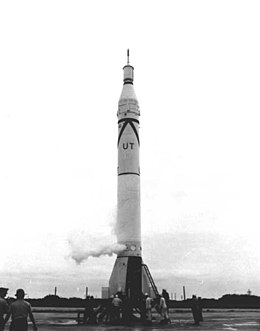 Juno I rocket with Explorer 3 satellite | |
| Names | Explorer III 1958 Gamma |
|---|---|
| Mission type | Earth science |
| Operator | JPL / U.S. Army Ordnance |
| Harvard designation | 1958 Gamma |
| COSPAR ID | 1958-003A |
| SATCAT no. | 00006 |
| Mission duration | 93 days (achieved) 120 days (planned) |
| Spacecraft properties | |
| Spacecraft | Explorer III |
| Spacecraft type | Science Explorer |
| Bus | Explorer 1 |
| Manufacturer | Jet Propulsion Laboratory |
| Launch mass | 14.1 kg (31 lb) |
| Payload mass | 8.4 kg (19 lb) |
| Dimensions | 203 cm (80 in) length 15.2 cm (6.0 in) diameter |
| Power | 60 watts |
| Start of mission | |
| Launch date | 26 March 1958, 17:38:01 GMT |
| Rocket | Juno I (RS-24) |
| Launch site | Atlantic Missile Range, LC-5 |
| Contractor | Army Ballistic Missile Agency |
| Entered service | 26 March 1958 |
| End of mission | |
| Last contact | 28 June 1958[1] |
| Decay date | 28 June 1958[1] |
| Orbital parameters | |
| Reference system | Geocentric orbit[1] |
| Regime | Medium Earth orbit |
| Perigee altitude | 186 km (116 mi) |
| Apogee altitude | 2,799 km (1,739 mi) |
| Inclination | 33.38° |
| Period | 115.70 minutes |
| Instruments | |
| Cosmic Ray counter Micrometeorite detector | |
Explorer Program | |
Explorer 3 (Harvard designation 1958 Gamma) was an American artificial satellite launched into medium Earth orbit in 1958. It was the second successful launch in the Explorer program, and was nearly identical to the first U.S. satellite Explorer 1 in its design and mission.